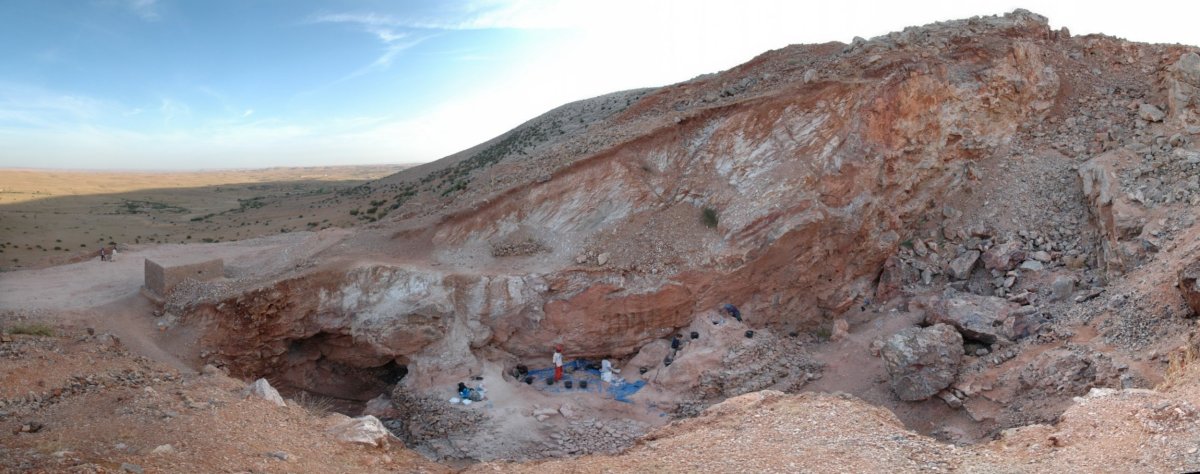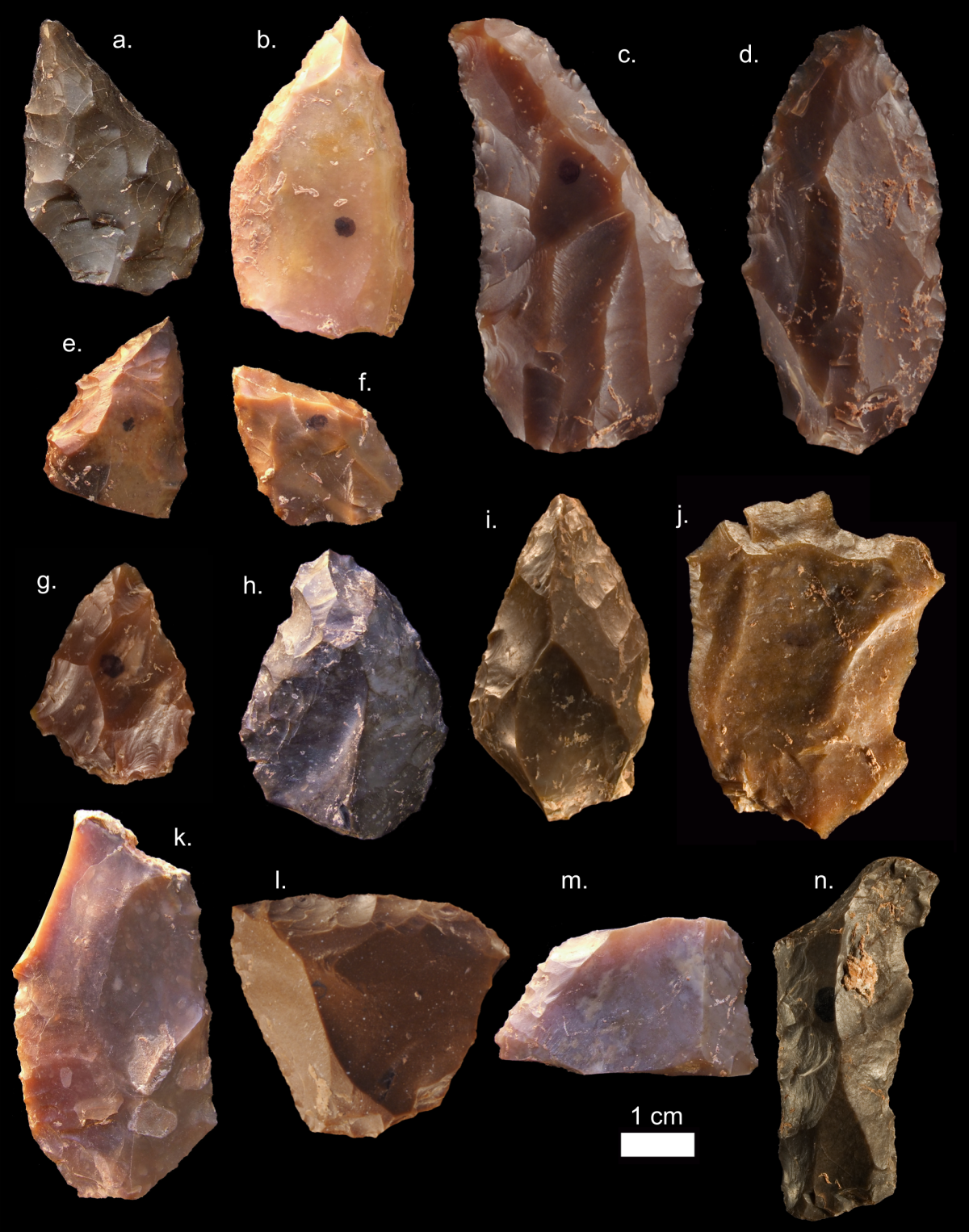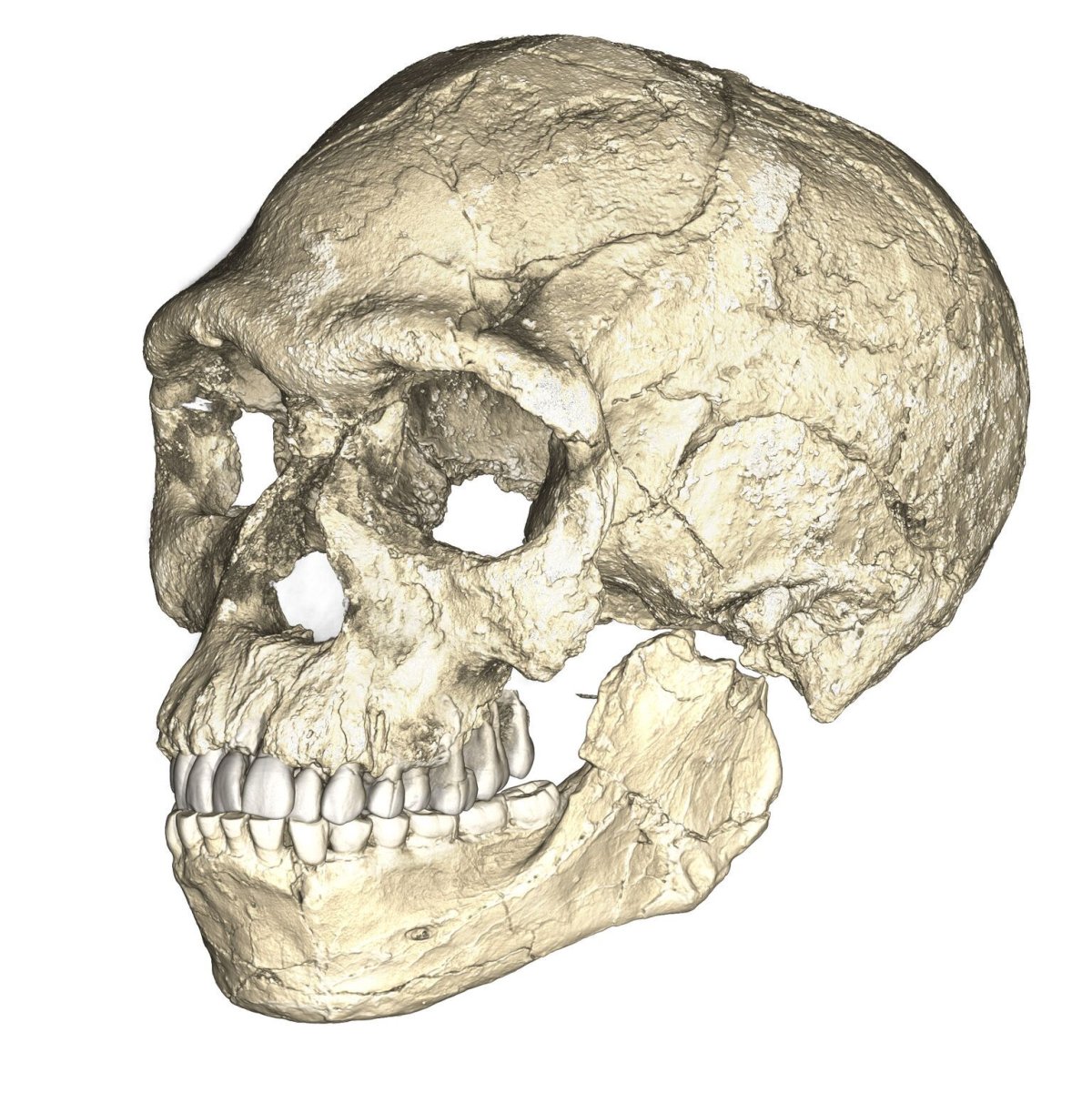
The earliest Homo sapiens fossils ever found have been unearthed at a site in Morocco, in northwest Africa—far away from the "cradle of humanity" of southern and East Africa we tend to associate with the birthplace of our species.
At the cave site of Jebel Irhoud, researchers discovered the fossil remains of five individuals dating back 300,000 years. They were found alongside stone tools, animal bones and charcoal, indicating the controlled use of fire.
This discovery pushes back the oldest fossil evidence of our own species by 100,000 years—the previous oldest Homo sapiens remains came from Omo Kibish, in Ethiopia, and date to 195,000 years ago.
Two studies announcing the findings have been published in the journal Nature. In one, scientists document the morphological features of the fossils, showing how this early version of a human would have looked remarkably like what we do today. The other paper focuses on the dating of the site, with scientists using new techniques to establish how old the tools and remains were.
The fossils unearthed are not true Homo sapiens, the researchers note. They have a variety of features—while their cranium appears archaic, belonging to an earlier ancestor, their facial features are remarkably close to modern-day humans. Because of these features, the team say the site "documents early stages of the Homo sapiens clade in which key features of modern morphology were established."
In total, the researchers located remains of five individuals—one of them a child. They were able to identify them through bits of skull, teeth and longer bones.
Finding such ancient evidence of early humans so far from where we thought our species began raises a multitude of questions. It also produces a hugely complicated picture of what could have been happening across Africa in terms of hominin dispersal and the various factors that would eventually lead our species to become what it is today.
"We used to think that there was a cradle of mankind 200,000 years ago in East Africa, but our new data reveal that Homo sapiens spread across the entire African continent around 300,000 years ago. Long before the out-of-Africa dispersal of Homo sapiens, there was dispersal within Africa," study author Jean-Jacques Hublin said in a statement.
Hunters chasing gazelle across Africa
The authors say these early Homo sapiens had potentially moved north across Africa—when the savanna was greener—following gazelle. Because the stone tools date from the same period as the fossils, researchers say these early humans had brought their hunting technology with them.
How or why these five dead individuals ended up being left at the site with the tools and animal remains is unknown. Shannon McPherron, an author on the dating study, tells Newsweek the deposits were found in very close proximity—just a few meters—from one another. "We have stone tools, bones of animals they consumed, and human fossils," she says. "We also have evidence of fire. The fire is important because it suggests that this is where they were living and not just a refuse area.

"What I can say is that we have no evidence of burial. It doesn't mean they weren't buried—but we have no indication that they were. And we have no bones in anatomical connection. At the same time we are frustrated by the fact that we have a very small window into what was once a much larger site. Had we been able to excavate more of it, perhaps we could have found additional evidence that would have allowed us to say more about how these various elements came together in this deposit.
"Adding to the mystery is the fact that we have at least five individuals represented. There are relatively few sites that have produced this many human fossils." She says the team is hoping to excavate the site further, but are "waiting to be sure we had good dates for the deposits before continuing."
Researchers now believe Homo sapiens evolved earlier than previously thought and that they had dispersed across Africa some 300,000 years ago. This, McPherron says, is likely the result of technological innovation during the Stone Age—their use of tools allowed them to travel and survive in new territories far from where they first started.

Complicated picture of human evolution
But the idea that Homo sapiens ended up in Morocco by dispersing from elsewhere in Africa doesn't have everyone convinced. As scientific dating techniques improve and as more archeological sites are found, the picture of human evolution that is emerging becomes less and less straightforward.
It was once thought the first Homo sapiens emerged in East Africa and moved outward, eventually ending up in Europe and further afield. But more recent discoveries complicate this. A partial cranium from Florisbad, South Africa, had previously been dated to 260,000 years ago. This fossil has characteristics of Homo sapiens, but like the Morocco fossils, retained more archaic features too.
How two hominins with Homo sapiens features ended up on other sides of Africa at a relatively similar time period indicates a hugely complex evolutionary history.
Iain Morley, a paleoanthropologist at the University of Oxford, tells Newsweek the current findings are extremely interesting and "add a further piece to the jigsaw puzzle" of human evolution.
He says there are problems when it comes to defining a species—and saying these fossils represent early Homo sapiens is something of a moot point. "By necessity you've only ever got little snapshots in the dark," Morley says. "What you're trying to do is join those snapshots up. But of course in nature it's very difficult to put your finger on the moment when something goes from being one species to another. That doesn't really happen biologically.
"There isn't a magic moment when something becomes human when before it wasn't. You've got development of a mosaic of features. Those characteristics will be evolving and emerging at different times and in different places. The question is, When do they come together to become a recognizable whole?"
In terms of when or where the first Homo sapiens emerged, Morley says, "I think the jury's very much out. Not least because it increasingly looks like we've got a lot of different variations of what you would call archaic or early Homo sapiens in different places at different times.
"What we'll hope to do in the coming decades is to try and figure out how the extent to which there was gene flow between those different populations. Were they isolated from one another? How did the different features we now think of as modern humans today become fixed? Where did they emerge? And when do we see them all together in one place at one time?"
Nick Barton, also from Oxford University, has worked at archeological sites in northwest Africa studying human evolution for the last 20 years. He says the latest findings are not surprising, but that they do shine a new light on the region, "which very often gets left out of the story."
"One of the key things is it raises a number of interesting questions," Barton tells Newsweek. "Did all this develop independently—this material culture—or does it imply, as the authors suggest, that there was some link across the Sahara, that people were moving across the Sahara and carrying with them their Middle Stone Age culture."

He says it is reasonable to think these proto–Homo sapiens developed independently, adding it's possible that they dispersed across Africa early, and then became isolated—developing their own cultural attributes.
Another option could be that the species evolved in Morocco and then moved south—although Barton points out there is no evidence to support this.
"My take is that there were various centers where we see these glimmerings of human development, and this might well have been one of them," he says. "Originally the evolutionary tree was very slender, almost a pine with nodes going all the way up in one direction. But now it's a great big bushy oak tree with lots of different branches and divergences. It's quite possible that parallel evolution is going on, convergent evolution—with different people developing at different rates."
He said the next thing will be to find other sites that can expand our picture of what was going on in Africa at this time.
"I think it's inevitable," "Morely says, "that the picture we have at any one time is simpler than the reality. Our understanding is always partial, and it's probably absolutely true to say the reality was more complicated than we think. Over and over again, as our scientific techniques become more refined, that's proven to be the case. The story is more complicated."
Uncommon Knowledge
Newsweek is committed to challenging conventional wisdom and finding connections in the search for common ground.
Newsweek is committed to challenging conventional wisdom and finding connections in the search for common ground.
About the writer
Hannah Osborne is Nesweek's Science Editor, based in London, UK. Hannah joined Newsweek in 2017 from IBTimes UK. She is ... Read more
To read how Newsweek uses AI as a newsroom tool, Click here.








